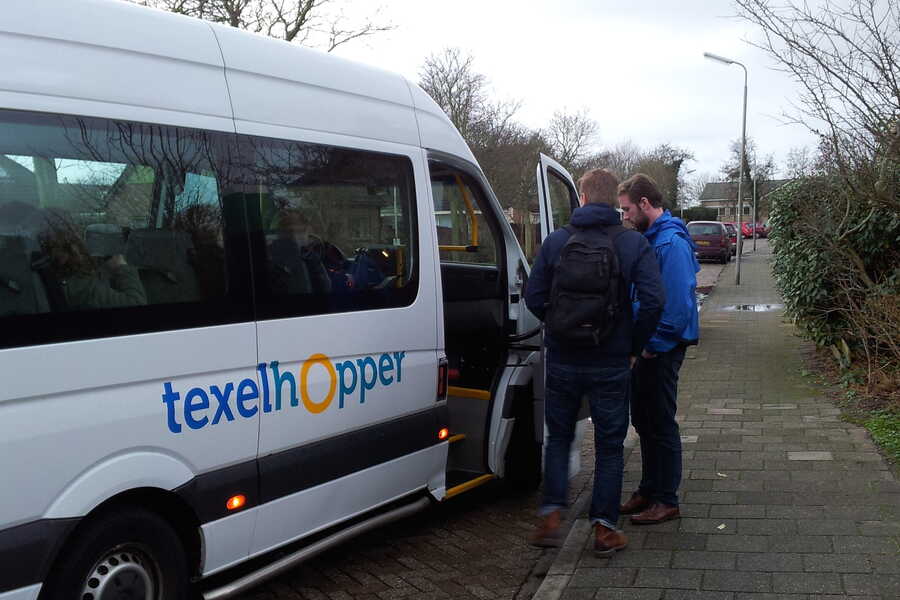Findings
Despite our intensive research before we went to Texel, our view has been changed this week. This section displays our findings of this week and will indicate how we can adopt these in our final design. Our initial idea focused on four different modes: public mode, private mode, a tourist attraction and a mode concerning transportation of goods and people with driverless vehicles. We came up with short-term solutions for the private and public mode and recognised long-term trends in the tourist attraction and transportation mode. When presenting these to the big group on Texel, the driverless vehicles were picked up as a unique possibility for Texel. Therefore we have developed a driverless vehicle vision that will eventually incorporate the three other modes. However, the “everyday” mobility (the bakfietsen bike rental, the carpooling initiative, etc) that we had plans for will not be a part of the last presentation here on Texel but could still be implemented. Since these initiatives have a smaller time frame, these are easier to implement.
After talking to Pieter de Vries of Gemeente Texel, who is working with the Texelhopper project, we realized that the public transport sector on the island involves more aspects than we thought upfront. The Texelhopper project has just started, but it is innovative and has a promising future. We also found out that there is interest in making Texel a test location for new technologies. Riding the Texelhopper and speaking to the driver, we realized the importance of the social role of the drivers on the busses.Moreover the bus drivers fulfil a very important in the local community, by bridging the different subgroups and the different villages. Moreover, by making all public transport driverless, these local people would lose their job and this could have a negative effect in a small community like Texel. These are notions that we have incorporated in our final design.
Regarding the Texelhopper project, there is always room for improvement. What we would like to see happen is more focus on fuel in existing public transport/taxis to make them even more sustainable, for example by changing from diesel or gasoline to biofuels or electricity. This is done in the private car sector to some extent, but not in the public. During our interview with Pieter de Vries we found out that the willingness is present but the financial capital is lacking.
Vision
Based on our analysis, we foresee a future mobility system that slowly transitions into a mobility system where electric mobility will become more and more important. Furthermore, we foresee a future where the client (people using the mobility system) becomes more demanding. Just as they can find anything they want to know, at any time, wherever they are as long as they have an internet connection, people will more and more require this same kind of flexibility and tailor-fit solutions in other areas of life. Mobility is not an exception to this.
Another trend that has been described is the emergence of the lease economy. With the tendency that people lease their assets whenever they need them, instead of owning them and having a regular monthly bill to pay for using it, this will have an effect to the mobility and transportation system of people as well. It is probable that in the future less people will own a car for instance, but lease the car whenever they need it. And why would people need to drive a car to get from A to B, when the car can drive them to their desired location on its own? Driverless vehicles are slowly getting to the market and within 20 years these cars could have become mainstream. This means that at any time of the day or night, you can order such a car to bring you from A to B and since no driver is required, personnel costs can be maintained relatively low. As personnel costs are usually the highest costs in an enterprise, it does not necessarily have to be expensive.
After conducting the research, the conclusion is that driverless electric vehicles form a crucial part of the future subsystem. However, before Texel as a whole can transition into this new future subsystem, it will have to go through certain phases just like any innovation.
The initial focus for the driverless sustainable mobility system is on the tourists. By doing this, Texel can stand apart from other tourist destinations and emit its innovation ambiance to the world. They will be able to make use of driverless vehicles, that can transport the tourists along certain routes over the island. These routes connect points of interest that showcase sustainable products and companies that enhance the identity of Texel. At the beginning, this could be on a small closed track where no other traffic is allowed. When successful, it can be expanded to larger areas of the island. When the Texelaars got used to the idea, the electric rental cars for lease could then also become driverless. This would result in a final transition into an almost completely driverless vehicle island. An innovation island.


